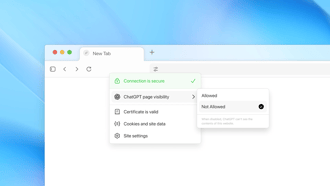Autonomous AI systems aren’t just reshaping industries—they’re redefining what it means for technology to act independently. Imagine self-driving cars smoothly navigating city streets, robotic surgeons performing complex procedures with unprecedented precision, or drones autonomously delivering critical medical supplies. These powerful systems hold enormous potential for boosting efficiency, reducing costs, and enhancing accuracy across multiple sectors.
Yet, alongside their incredible promise comes substantial risk. Without the right oversight, autonomous AI can make decisions that endanger lives, assets, and reputations. Balancing the remarkable capabilities of autonomous AI with careful human-in-the-loop (HITL) oversight is crucial for businesses looking to harness these technologies safely and effectively.
Autonomous vehicles use AI and sensors to navigate city streets in real time. Source: Unsplash.
Here, we’ll explore both the extraordinary opportunities and significant challenges of autonomous AI. We’ll delve into how incorporating platforms like CloudFactory can help you navigate risks, ensure reliability, and maintain accountability in an increasingly autonomous world.
What are autonomous AI systems?
Autonomous AI systems are artificial intelligence programs that are trained using large amounts of data to make and act on independent decisions. In effect, they rely on prior history and experience to make judgments about what to do in similar situations.
Although similar to generative AI technology, and sometimes overlapping in scope, autonomous AI systems focus on producing decisions and actions, rather than content. A generative AI chatbot program, like ChatGPT or Claude, can create text or images, but does not immediately do anything with it. A self-driving car, on the other hand, makes real-time decisions to stop, turn, or accelerate.
The great thing about autonomous AI is that it can handle complex tasks with minimal human input. However, it is crucial to remember that no such system is infallible. AI can make mistakes just like humans can, which means that there are serious questions of risk and accountability when using the technology in high-impact sectors like healthcare or finance.
Autonomous AI systems can learn, adapt, and make decisions without direct oversight through ongoing training and reinforcement learning. But they are prone to failure if not regularly validated. Some concerns include:
- Systemic discrimination against marginalized groups, due to bias in the original training dataset.
- Excessive false outputs in diagnosing problems.
- Exposure to hacking or security breaches could cause devastating consequences.
- Risky decision making, particularly in sectors like financial services.
- Over-optimization of one goal at the expense of others.
Examples of autonomous AI systems:
- Self-driving cars. Companies like Waymo and Tesla are producing autonomous vehicles that can navigate and avoid collisions on their own.
- Robotic surgery assistants. Tools like ROSA and Da Vinci help surgeons perform some surgeries with greater precision and control, sometimes even remotely.
- Autonomous Drones. Self-navigating drones from companies like Skydio and DJI are changing commerce and healthcare by delivering goods and medical supplies.
- AI Assistants. These AI-powered virtual assistants can automatically handle simple tasks, like scheduling appointments, answering routine emails, checking social media, or performing basic data analysis.
The importance of HITL for autonomous AI
Machine learning algorithms, neural networks, and deep learning enable autonomous systems to streamline decisions, but they always require human-in-the-loop (HITL) oversight for reliability.
HITL oversight ensures ethical decisions, bias mitigation, and safety compliance. Depending on the application in question, this may take many different forms. For high-quantity, low-risk situations, the amount of human oversight is minimal, and quality checkers may only look at a small sample of decisions. For high-impact, potentially life or death situations, the amount of oversight is high, and humans may play an active role in at least reviewing or checking most or all decisions made by the system.
CloudFactory helps integrate human expertise to validate and ensure accountability in AI decisions. Through high-quality datasets, fine-tuned language models, and human oversight of AI models, we help businesses make their systems as safe and reliable as possible.
Challenges and considerations in implementing autonomous AI
Autonomous AI can be used safely in many business settings, but the consequences can be severe if the implementation is not well thought out.
- Ethical concerns. Whenever you transfer decision-making from humans to machines, you thereby transfer some accountability along with the automation. This leads to concerns about who is to blame when something goes wrong, such as an AI delivering a false diagnosis to a patient.
- Data privacy. AI algorithms tend to rely on huge amounts of training data to operate. This data is often sensitive and personal in nature, meaning that businesses should take care to respect privacy laws and the preferences of their customers.
- AI transparency. It's a good idea to be upfront about your use of AI, especially when it makes important decisions. Those impacted will want to know.
- Regulatory compliance. Although there are currently few laws that specifically target AI systems, more will certainly be coming. In the meantime, firms need to be aware of triggering any relevant data privacy and consumer protection laws.
- Failure scenarios. There is a serious danger in AI failures in critical systems like healthcare or transportation. Such failures can result in misdiagnoses, vehicle collisions, and more. Businesses using AI models in these sectors need rigorous oversight to manage such risks.
Looking ahead: The future of autonomous AI
Autonomous AI systems are approaching human-like capabilities in specific tasks, but we need human oversight to ensure reliability and accountability. Future trends are likely to improve safety, but not to remove the need for humans in the loop altogether.
Some emerging trends include:
- Autonomous AI agents. These advanced AI tools act like a real human being on a computer, with the ability to browse the web, send emails, click on links, and more.
- Multi-modal AI systems. Multi-modal systems can integrate information across different modalities, such as text, images, or raw data, to produce decisions. This can allow for richer, more nuanced judgments and greater adaptability.
- AI-human collaboration. These "centaur" systems integrate human and computer skills to optimize workflows. As businesses discover what AI systems are good at and what they are not, they gradually discover the gaps in AI capabilities that can be best filled by human intervention.
Build a safer future with autonomous AI
Autonomous AI is transforming countless industries around the globe, but its improper use presents risks that cannot be ignored. Effective human-in-the-loop oversight is essential for ensuring safe, reliable, and accountable AI systems.
CloudFactory helps businesses bridge the AI confidence gap by providing high-quality data annotation, HITL validation, and expert inference oversight. Our mission is to ensure reliable and trustworthy AI performance, even in high-risk domains. Want to make your AI system scalable, reliable, and trustworthy? Contact us today for more information about Autonomous AI or to consult with a CloudFactory expert about our services.
.png?width=1563&height=1563&name=Untitled%20design%20(38).png)




.png?width=1563&height=1563&name=Untitled%20design%20(30).png)



.png?width=1563&height=1563&name=Untitled%20design%20(33).png)


.png?width=1563&height=1563&name=Untitled%20design%20(34).png)













